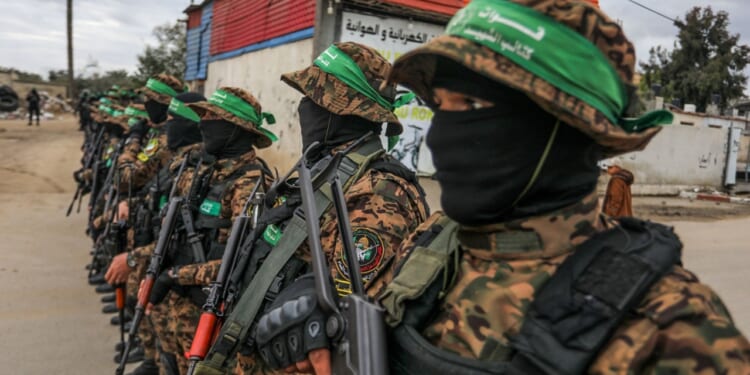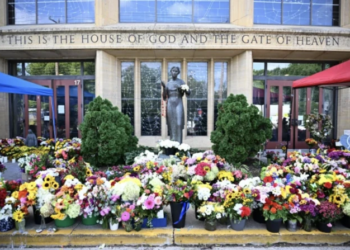Make no mistake, Hamas intends to live another day and continue its rule over Gaza.
According to a Wall Street Journal report, Hamas leader Khalil al-Hayya initially rebuffed President Trump’s peace initiative, which would have required Hamas to disarm with few guarantees from Israel for an end to hostilities. The proposal reached Hamas through negotiators from Qatar and Egypt. Al-Hayya’s refusal shifted only after Egypt and Qatar warned him that this offer represented Hamas’ final opportunity for organizational survival.
Retaining Israeli hostages provided strategic legitimacy for Israel’s ongoing campaign, which persisted despite criticisms at home. Israel’s leadership demonstrated clear determination to pursue the Gaza City operation, even knowing that hostages were being used to impede military advances. This credible military threat, fused with mounting diplomatic pressure, compelled Hamas leadership to reconsider its position.
Regional mediators—Qatar, Turkey, and Egypt—changed their approach only after President Trump incentivized cooperation. Qatar received an executive order from the White House guaranteeing protection from future Israeli military action, effectively a quasi-Article Five security assurance, alongside permission for a new Qatari air force facility at a US military base in Idaho.
Turkey may have been promised the easing of US sanctions and access to F-35 aircraft, modernizing its air force after years of exclusion from US fighter programs. Egypt regained its status as chief mediator and hosted the postwar summit in Sharm el-Sheikh, reclaiming its centrality in regional diplomacy.
This sequence proved what many in Israel had believed: these states held leverage over Hamas but had not exercised it, either due to their alignment with Hamas or the absence of clear incentives. The Wall Street Journal confirmed that Turkey and Qatar threatened to expel Hamas’ leadership from their countries. At the same time, Egypt, responding to US pressure, agreed to stop lobbying for a Hamas role in postwar Gaza.
Hamas publicly accepted the initial phases of President Trump’s plan but refused to disarm. Hamas spokesman Bassem Naim has previously insisted before the ceasefire that Hamas would not surrender its weaponry, emphasizing that armed jihadist groups do not simply abandon the core tenet of their organizational survival.
The future governance of Gaza remains the principal dispute under the agreement. While Hamas has claimed it may hand over “offensive” weapons such as rocket launchers—claims that should be scrutinized carefully—it has explicitly refused to give up light weaponry, which it wields to control rivals and punish collaborators. In the interim, Hamas is reasserting its dominance on the streets through paramilitary units like Sahem and terrorizing potential rivals.
Hamas’ best long-game strategy is to push for representation in whatever Palestinian governance structure emerges, along with other Palestinian factions. The Donald Trump peace plan includes a proposal for a “temporary transitional governance of a technocratic, apolitical Palestinian committee.” However, the effective result could be similar to the pre-war Lebanese model, where a de jure Lebanese state existed alongside a powerful Hezbollah.
Egypt, which has announced plans to convene a Palestinian national dialogue on the future of Gaza in which Hamas will take part, and Turkey, whose leaders have called Hamas a “resistance movement,” would make sure that the Hamas mechanisms survive even as they adapt to the new framework.
Hamas is currently dragging its feet in retrieving the remaining bodies of deceased hostages, citing difficulties with recovery. This could be a pretext to gather more support and retain its foothold in Gaza.
The coming months and years will likely reveal considerable uncertainty in the actual implementation of the plan in accordance with President Trump’s 20 points. With the attention of the US administration shifting elsewhere, it would be the perfect time for Hamas to reconstitute itself under the auspices of a legitimate governing authority, and then continue to funnel billions into rebuilding terrorist infrastructure.
Peacekeeping forces don’t have a promising track record in the Middle East. UNIFIL in Lebanon not only did not stop Hezbollah but also turned a blind eye to its activities. The only force capable and willing to dismantle the terrorist infrastructure, like the hundreds of miles of underground tunnels that have not been found, is the IDF.
About the Author: Atar Porat
Atar Porat is a researcher at the David Institute for Security Policy, an independent, non-profit think tank based in Israel.
Image: Anas-Mohammed / Shutterstock.com.


















